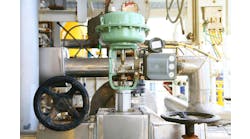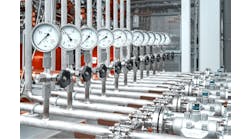|
V |
alves are such a common element in multivariable production and process control systems that in spite of their often critical role in loop performance, the process industries seem to be taking them for granted. In 2003, Honeywell Process Solutions released a study covering the performance of more than 100,000 control loops. Of those loops, the analysis revealed 49% were performing poorly and that 16% percent of those had sticky valves.
At a control valve seminar it held that year, Emerson Process Fisher Control’s Joe Herink, director of PlantWeb Sales said “As many as 80% of the process loops today do not reduce process variability and the control valve is the leading culprit.” At the heart of the problem were poorly specified and installed valves.
What I’m driving at here is that loop performance relies a great deal on valve performance. But in spite of valves’ critical role, companies seem not to be applying the resources (that’s time, money, effort) to support the proper specification and maintenance of control valves in the plants they build and operate. Add to this a host of fundamental technical issues that contribute to an individual valve’s price, as well as its total cost of ownership (TCO),and its impact on overall system/operational costs.
But the buck doesn’t stop there because the economic dynamics flowing through valves don’t shut off with the price of the technology. Simply, loop performance has everything to do with precise valve control, and loop performance has everything to do with product quality and plant profitability. Hence, precision valve control equals profitable operations.
Gary Hawkins, a senior technical specialist at UOP LLC, the well-known supplier of process technology and consulting services to the refining industry located in Des Plaines, Ill., says the process units they design often include specs for 50–100 control valves. “Our focus is on the overall control-loop performance and the control valves and actuator technologies we specify are driven by the process dynamics we are seeking to control.”
Hawkins and I spoke about how issues with dead time, response time, valve stiction and other valve maladies are often the enemies of precise process control and how getting past those issues often comes down to the price one has to pay to attain precise valve control.
Are UOP clients willing to pay for the necessary valve, fast actuator and digital control technologies that will get them through the process performance weeds and into the sweet clover that precision valve control can deliver? Hawkins says his clients rely on UOP expertise to specify what will work, but he concedes there is pressure to cost-justify all components and the discussion can get pretty rigorous when not every benefit can be broken down into those hard-numbered metrics that the bean—excuse me—cost-conscious financial executives need when assigning scarce capital resources. “Sometimes it takes a bit of faith,” says Hawkins, “but the benefits of advanced valve technologies are real. Although it is difficult to quantify them precisely on an individual basis because of the interactions with the overall system. I try to convince any skeptics that technologies that can hold the loop closer to the desired setpoints, and that can respond to upsets in a stable manner, have a great deal of downstream value and far outweigh their incremental costs—especially when you also consider the avoidance of unplanned downtime and the benefits of diagnostics.”
Fortunately, valve and actuator technologies continue to advance and it’s likely engineers won’t have to work so hard to cost-justify valves that ensure precise flow control. One company with a better idea is Woodward Governor Co. of Rockford, Ill. Recently, the company introduced an all-electric integrated control valve system for gas flow control systems. At the heart of the valve is a stem seal design that creates a cascading series of TCO benefits because the actuator no longer has to overcome the extreme clamping forces needed to seal the packing against fugitive emissions. There’s no need for high-torque pneumatic or hydraulic actuators (or its incumbent hardware) to overcome stem friction loads; a small, less-expensive motor does the job. It’s also delivered as system, complete with digital controls that enable contemporary asset management/networking scenarios—and that helps ease specification/procurement hassles.
Precision flow control is ensured with well-specified, well-maintained and precisely-controlled valves, but for the sake of your process, a penny saved may not necessarily be a penny earned.



